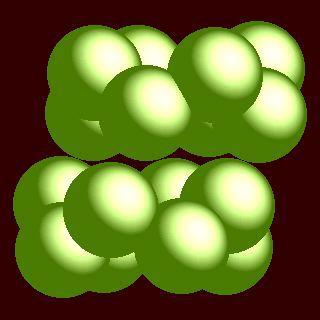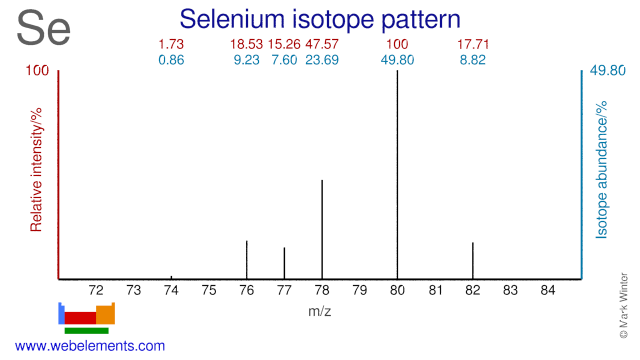Selenium - 34Se: the essentials
- Name: selenium
- Symbol: Se
- Atomic number: 34
- Relative atomic mass (Ar): 78.971 (8) r
- Standard state: solid at 298 K
- Appearance: grey, metallic lustre
- Classification: Non-metallic
- Group in periodic table: 16
- Group name: Chalcogen
- Period in periodic table: 4
- Block in periodic table: p
- Shell structure: 2.8.18.6
- CAS Registry: 7782-49-2
Selenium atoms have 34 electrons and the shell structure is 2.8.18.6. The ground state electronic configuration of neutral selenium is [Ar].3d10.4s2.4p4 and the term symbol of selenium is 3P2.
Selenium: description
Selenium can be prepared with either an amorphous or crystalline structure. Crystalline monoclinic selenium is deep red; crystalline hexagonal selenium, the most stable variety, is a metallic grey (see picture above). Elemental selenium is relatively nontoxic and is considered to be an essential trace element. However, hydrogen selenide (H2Se) and other selenium compounds are extremely toxic, and resemble arsenic in their physiological reactions. Hydrogen selenide in a concentration of 1.5 ppm is intolerable to man. Selenium occurs in some soils in amounts sufficient to produce serious effects on animals feeding on plants such as locoweed (an American plant) grown in such soils.
Selenium: physical properties
Density of solid: 4819 kg m-3
Molar volume: 16.42 cm3
Thermal conductivity: 0.52 W m‑1 K‑1
Selenium: heat properties
Melting point: 494 [221 °C (430 °F)] K
Boiling point: 958 [685 °C (1265 °F)] K
Enthalpy of fusion: 20.5 kJ mol-1
Selenium: atom sizes
Atomic radius (empirical): 115 pm
Molecular single bond covalent radius: 116 (coordination number 2) ppm
van der Waals radius: 182 ppm
Selenium: electronegativities
Pauling electronegativity: 2.55 (Pauling units)
Allred Rochow electronegativity: 2.48 (Pauling units)
Mulliken-Jaffe electronegativity: 2.60 (16.7% s orbital)
Selenium: orbital properties
First ionisation energy: 940.96 kJ mol‑1
Second ionisation energy: 2045.1 kJ mol‑1
Third ionisation energy: 3058.3 kJ mol‑1
Selenium: abundances
Universe: 30 ppb by weight
Crustal rocks: 50 ppb by weight
Human: 50 ppb by weight
Selenium: crystal structure

Selenium: biological data
Human abundance by weight: 50 ppb by weight
Selenium is essential to mammals and higher plants, but only in small amounts. Selenium is said to stimulate the metabolism. It may help protest against free radical oxidants and against some heavy metals. Livestock grown in areas containing high amounts of selenium in the soil and in which a plant called Astragalus ("loco weed" in USA) is present are poisoned. This is because Astragalus concentrates selenium. On the other hand, sheep grown in areas containing deficient amounts of selenium in the soil develop "white muscle disease".
Selenium: uses
Selenium: reactions
Reactions of selenium as the element with air, water, halogens, acids, and bases where known.
Selenium: binary compounds
Binary compounds with halogens (known as halides), oxygen (known as oxides), hydrogen (known as hydrides), and other compounds of selenium where known.
Selenium: compound properties
Bond strengths; lattice energies of selenium halides, hydrides, oxides (where known); and reduction potentials where known.
Selenium: history
Selenium was discovered by Jöns Berzelius in 1817 at Sweden. Origin of name: from the Greek word "selene" meaning "moon".Selenium: isotopes

Selenium isotopes are mainly used for the production of medical and industrial radioisotopes. Se-77 and Se-78 are used for the production of the therapeutic radioisotope Br-77. Se-80 is used for the production of the medical radioisotope Br-80m. Se-74 is used for the production of Se-75 which is used as a source in gamma radiography. Se-76 can be used for the production of the medical isotopes Br-75 and Br-76. Se-82 has been used to study double beta decay. Most of the Selenium isotopes have been used in studies into the role of Selenium as an essential nutrient.
Selenium: isolation
Isolation: it is not usually necessary to make selenium in the laboratory as it is commercially available. While there are several selenium ores, most selenium is made as a byproduct of copper refining. It also accumulates in the residues from sulphuric acid manufacture. Extraction is complex since the method emplyed will depend upon what other compounds or elements are present. The first step usually involves an oxidation in the presence of sodium carbonate (soda ash).
Cu2Se + Na2CO3 + 2O2 → 2CuO + Na2SeO3 + CO2
The selenite Na2SeO3 is acidified with sulphuric acid. Any tellurites precipitateout leaving selenous acid, H2SeO3, in solution. Selenium is liberated from selenous acid by SO2
H2SeO3 + 2SO2 + H2O → Se + 2H2SO4
